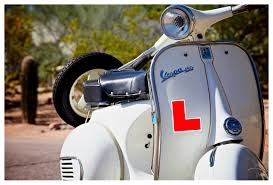Understanding the Significance of Motorbike L Plates for Learner Riders

The Importance of Motorbike L Plates
Motorbike L plates are a vital element for new riders embarking on their journey in the world of motorcycling. These distinctive plates, featuring a red ‘L’ on a white background, serve as a visual indicator to other road users that the rider is still learning and may not have the same level of experience as seasoned bikers.
For many new riders, obtaining a motorcycle licence is a significant achievement. However, it is crucial to remember that riding a motorbike requires skill, practice, and constant awareness of road safety. Motorbike L plates help communicate this message to other drivers, encouraging them to be patient and considerate towards learner riders.
By displaying L plates prominently on their motorcycles, new riders signal their willingness to learn and improve their riding abilities. This visible reminder serves as a reminder to both the rider and other road users that caution and understanding are essential when sharing the road.
Additionally, motorbike L plates are often required by law for learner riders in many countries. Adhering to these regulations not only ensures compliance with legal requirements but also promotes a culture of responsibility and safety among motorcyclists.
As new riders gain confidence and experience on the road, they will eventually progress beyond the need for L plates. This transition symbolizes their growth as motorcyclists and their increasing proficiency in handling different riding situations.
In conclusion, motorbike L plates play a crucial role in promoting safety, awareness, and respect on the roads. By embracing these symbols of learning and development, new riders contribute to creating a harmonious environment for all road users while honing their skills as responsible motorcyclists.
Essential Tips for Properly Displaying Motorbike L Plates in the UK
- Display L plates clearly on the front and back of your motorbike.
- Make sure the L plates are the correct size (minimum 178mm x 178mm) and meet legal requirements.
- Avoid altering or modifying the appearance of the L plates as this may make them invalid.
- Replace damaged or faded L plates promptly to ensure they are always visible.
- Do not cover any part of the L plate with accessories or equipment that may obstruct visibility.
- Follow regulations regarding where to place L plates on your motorbike for maximum visibility.
- Remember to remove L plates once you have passed your motorcycle test and no longer need them.
- Check local laws and regulations regarding displaying L plates in specific areas or countries.
- Always carry spare L plates in case you need to replace them during a journey.
Display L plates clearly on the front and back of your motorbike.
To adhere to the recommended practice regarding motorbike L plates, it is essential to display them prominently on both the front and back of your motorcycle. By ensuring that the L plates are clearly visible from all angles, you communicate your learner status effectively to other road users. This proactive approach not only enhances safety by alerting drivers to your learning status but also demonstrates your commitment to responsible riding practices. Displaying L plates on both ends of your motorbike promotes visibility and awareness, contributing to a safer and more considerate road environment for all.
Make sure the L plates are the correct size (minimum 178mm x 178mm) and meet legal requirements.
It is essential to ensure that the L plates displayed on your motorbike are the correct size, with a minimum dimension of 178mm x 178mm, to meet legal requirements. By adhering to these specifications, you not only comply with regulations but also enhance visibility for other road users. Properly sized L plates help communicate your learner status effectively, promoting safety and awareness on the road. Remembering to check and maintain the correct size of your L plates is a simple yet crucial step in promoting responsible motorcycling practices.
Avoid altering or modifying the appearance of the L plates as this may make them invalid.
It is important for motorbike riders to avoid altering or modifying the appearance of the L plates, as doing so may render them invalid. The design and visibility of L plates are specifically regulated to ensure that they are easily identifiable by other road users. Any changes to the size, colour, or layout of the L plates could compromise their effectiveness and legality. By keeping the L plates in their original state and displaying them as required by law, riders can help maintain road safety standards and adhere to legal regulations governing learner riders.
Replace damaged or faded L plates promptly to ensure they are always visible.
It is important to replace damaged or faded motorbike L plates promptly to ensure they are always visible to other road users. Clear and legible L plates are essential for indicating that the rider is still learning and may require extra caution from fellow drivers. By maintaining the visibility of L plates, new riders can communicate their status as learners effectively and promote a safer riding environment for themselves and others on the road.
Do not cover any part of the L plate with accessories or equipment that may obstruct visibility.
It is essential for motorbike riders to adhere to the tip of not covering any part of the L plate with accessories or equipment that may obstruct visibility. By ensuring that the L plate remains fully visible, riders communicate their learner status effectively to other road users, promoting mutual respect and caution on the roads. Keeping the L plate unobstructed enhances safety by allowing drivers to recognise and accommodate learner riders, fostering a conducive environment for skill development and responsible motorcycling practices.
Follow regulations regarding where to place L plates on your motorbike for maximum visibility.
It is essential for new riders to adhere to regulations regarding the placement of L plates on their motorbikes to ensure maximum visibility. By following these guidelines, such as positioning the plates in a clearly visible location on both the front and rear of the motorcycle, learners can effectively communicate their status to other road users. Placing L plates in the correct position not only enhances safety by alerting drivers to the presence of a novice rider but also demonstrates a commitment to responsible and law-abiding motorcycling practices.
Remember to remove L plates once you have passed your motorcycle test and no longer need them.
It is essential to remember to remove your motorbike L plates once you have successfully passed your motorcycle test and are no longer required to display them. By taking this simple step, you not only comply with legal regulations but also signify your progression from a learner rider to a fully qualified motorcyclist. Removing the L plates serves as a symbolic gesture of your achievement and signifies your readiness to navigate the roads with increased confidence and expertise.
Check local laws and regulations regarding displaying L plates in specific areas or countries.
It is essential for motorcyclists to be aware of and adhere to local laws and regulations concerning the display of L plates in specific areas or countries. Before hitting the road, riders should take the time to research and understand the requirements regarding the use of L plates in their region. By checking and following these guidelines, riders can ensure compliance with legal obligations and promote a culture of safety and responsibility while riding. Being informed about local laws regarding L plates is a crucial step towards maintaining road safety and fostering mutual respect among all road users.
Always carry spare L plates in case you need to replace them during a journey.
It is essential for motorcyclists to heed the advice of always carrying spare L plates while on the road. Having extra L plates readily available ensures that riders can quickly replace any damaged or lost plates during their journey. By being prepared with spare L plates, motorcyclists can maintain compliance with legal requirements and continue to communicate their learner status effectively to other road users. This simple precautionary measure helps ensure a smooth and uninterrupted riding experience, promoting safety and awareness on the roads for both the rider and fellow motorists.


